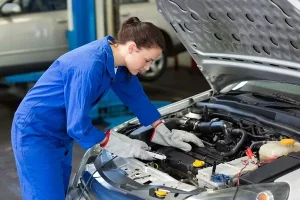What Are the Components of a Car Engine?

A car engine is a complicated part of your vehicle that works to produce the power you need to move around. It consists of a series of pistons, a cylinder head, a cylinder block and a valve. Each of these components have their own set of problems and maintenance tasks that you may have to perform on your vehicle.
Pistons
Pistons in car engines are vital for the transmission of power. They perform a myriad of functions, from compressing air and fuel to transferring energy to the crankshaft. If they don’t work properly, your vehicle could suffer from engine damage.
The piston in the cylinder is a thick metal plate that compresses the air and fuel mixture. It is attached to a conrod, which connects it to the crankshaft. When the piston moves up and down, it compresses the air and fuel mixture, releasing some of the heat energy produced during combustion.
In order to be useful, the piston must also be durable and light. A lightweight piston will lower fuel consumption and make your car more fuel-efficient.
Pistons in car engines are usually made of aluminium alloys. These alloys are very strong and lightweight. They are also very heat-resistant, so they can handle high temperatures. However, they require special treatment to ensure their long life.
Cylinder head
Cylinder head is one of the main components of an engine, as it is the basic framework for housing the spark plugs and injectors. It also contains passageways for coolant and oil.
The cylinder head of a car engine is usually made of cast iron or aluminium. Cast iron is preferred for engines using diesel fuel, due to its increased strength. Aluminium is used in virtually all production gasoline engines because it offers weight savings and dissipates heat better.
A cylinder head is a three-piece assembly, held in place by a flange. One side of the block is typically connected to an air intake and the other to an exhaust manifold.
There are several types of cylinder heads, but the most common is the crossflow type. This configuration features four valves per combustion dome and has a high flow coefficient.
CNC porting is an advanced machining process used to improve flow and shape the cylinder head. The cylinder head is then fitted into the engine frame.
Cylinder block
The cylinder block is the main structural framework of the car engine. Its function is to support the other parts of the engine and ensure its stability. There are many different types of cylinder blocks. Some are made from aluminum, while others are cast from gray iron.
Most engine blocks are equipped with an oil gallery. These passages allow oil to reach the cylinder head, crankshaft, and other engine parts. However, if these passages are blocked, it can prevent the proper functioning of the engine.
When you have an overheated engine, the cylinder block will expand and crack. This is a major problem and can be costly to repair.
If you notice a crack in the cylinder block, it is best to replace the cylinder. The cylinder is a very large part of the engine. Even small cracks can cause friction and increase wear.
Cylinders are circular openings where pistons pass through. These are usually made of aluminum alloy, but some small engines have cylinder walls coated with chromium to help reduce cylinder wear.
Valve
A car engine valve is an important component of an engine. It controls the flow of fluids or gases in and out of the cylinder. It also coordinates with other engine components, such as rocker arms and the exhaust gas recirculation system.
There are two types of valves. The first type is known as a poppet-style valve. It has a conical profile head that fits into a machined valve seat. The second type is called a sleeve.
The sleeve is a solid solution of steel on the valve cap. It is surrounded by water jackets and has ports on the sides. Ports on the sleeve coincide with the ports in the casting of the main cylinder. These ports allow the sleeve to drive out gases by periodic coincidence.
When an engine fails, the cylinder head needs to be replaced. However, modern car engines can last for a long time.
The most common type of failure is a burnt valve. Blue smoke is another common indicator.







